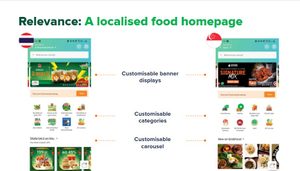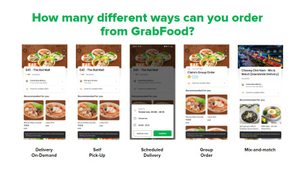Partner content in association with
How GrabFood is harnessing technology to overcome the challenge of food delivery in Southeast Asia
Photo: Grab
With delivery contributing 50% to Grab’s business, the engineering team is constantly working on improvements to the user experience, says Grab’s head of engineering deliveries Xiaole Kuang
While superficially a simple matter of placing an order and expecting a hot meal at your doorstep, food delivery is an incredibly complicated business. Companies in the space have to navigate the often contradictory expectations of multiple stakeholders. Among these are consumers who want a wide range of food and quick delivery at an affordable price; merchants who wish to increase their sales by serving as many customers as possible and finally drivers who want to maximise the number of deliveries made within a short timeframe, to earn more income.
Adding to the complexity of food delivery is Grab’s pan-Southeast Asia presence: a vast, non-homogenous region, where the differences in everything from cuisines to traffic conditions, can have a severe impact on the business.
Speaking at Grab Tech Insider, an online seminar that gave a deeper insight into the company’s food delivery business, Xiaole Kuang, Head of Engineering Deliveries at Grab said, “Engineers dream of having a generic platform, with a universally applicable solution. But the reality is different.”
This was driven home by data from Grab on the most ordered dishes across the region for dinner on New Year’s Eve. Different countries across Southeast Asia opted for bubble tea, fried chicken, burgers and pizza.
While variations in culinary tastes are perhaps only to be expected, extensive research from Grab reveals some fundamental differences in user behaviour across the region. For instance, consumers in Singapore or Manila enjoy browsing, but their counterparts in Jakarta or Ho Chi Minh City prefer having many options on a single page.
Tasked with meeting the constantly changing expectations of several different stakeholders in diverse geographies, Grab is constantly rolling out improvements and refinements to its delivery offering. There is a strong business imperative driving these changes. Deliveries contributed approximately 50% to Grab’s business as of end 2020 – particularly significant considering Grab’s relatively late entry into the space.
However the company has turned being a late mover into an advantage, avoiding the pitfalls that beset many of its predecessors. It has effectively deployed technology to address the pressing issues that have plagued this relatively nascent sector. Through the pandemic, Grab developed 120 product features across the entire vertical. Explaining its approach on food delivery in particular, Kuang said, “We are always thinking about how we can localise user experience at scale; delight eaters by driving sustainable demand to merchants; and deploy technology to protect the user experience.”
Localising for non-homogenous customers
To address the diversity of Southeast Asia, GrabFood has given its teams in each country freedom and the tools to customise the in-app experience.

At the browsing stage, GrabFood’s goals are to enable discovery of as many relevant options as possible.
If a particular dish or restaurant a user has searched for is unavailable or has less than 4 search results, the system presents other merchants with similar food on the menu.
Factors such as user profile, a merchant’s popularity and proximity to the consumer; the current order load and the number of drivers in the vicinity all help create a personalised list of in-app recommendations.
Over time, the system forms a more accurate profile of a user based on their budget and culinary preferences. This allows the recommendation engine to tailor its offerings by tracking real-time changes in search behaviour.
For example, fast food restaurants restaurants may not appear on the ‘recommended restaurants’ list by default. But if a user searches for food from a fast food restaurant, relevant options from chains with a similar profile will start to populate the section.
Streamlining food orders for merchants
A user on Grab now has more options than she ever did before, when it comes to ordering food on the platform.

Grab has ensured that the merchants are able to process these orders, irrespective of the delivery option chosen by a customer. Grab’s Order Platform is a control centre that receives all existing orders, and gives merchants as well as Grab’s support staff a 360 degree view into the process. The platform combines over 10 internal systems to ensure the information is up to date and that orders are processed like clockwork.
Merchants can also use this platform to update information on their restaurants such as changes in the menu or operating hours. At a deeper level, insights gleaned from Grab can help to highlight the best performing items on a restaurant’s menu and give the merchant valuable perspectives into user preferences. Using these analytical tools, merchants can tailor their offerings to resonate better with consumers.
Grab’s Open Platform also includes tools for merchants to link their point of sale (PoS) system to the GrabMerchant app for improved operational efficiency. That way, the merchant’s staff will not need to manually transfer order information from the GrabMerchant app into their point of sale (PoS) system, which can be resource intensive and prone to errors. To ensure a smooth adoption process, Grab offers step-by-step guidance, debugging tools, as well as tech support to make it easy for merchants to link both systems.
Protecting the consumer experience in adverse conditions
However, given the sheer complexity of food delivery and the number of variables involved, the customer experience can sometimes be sub-optimal. For example, a heavy downpour could lead to a surge in food orders and a rapid drop in available drivers, as people stay in to avoid the rain. Grab’s tech tries to prevent the customer experience from degrading by concentrating available drivers within a smaller delivery radius so that consumers are more likely to find a driver.
Grab has also come up with batching as a solution to improve its fulfillment rate during these crunch times. Multiple orders are assigned to a driver serving a particular pick up / drop off location. Kuang described batching as “A very hard problem to solve – finding the perfect match between orders, drivers and a route plan, which keeps the cost optimal.” However, she added, “It helps increase the chances for an eater to find a driver, besides improving order completion and fulfillment.” Acknowledging that order batching could potentially result in a longer wait, Grab has set acceptable time limits for the process.
Charting the future of food delivery
Food delivery is a complex operation, and Grab knows that the only way to stay ahead is to keep experimenting and enhancing its service. Grab has a few innovations that it will be rolling out through 2021. One of these will allow consumers to pre-order single serve meals. Since the food orders are being made in advance, Grab can further optimise its driver network for deliveries, resulting in valuable savings which can be passed on to the consumer in the form of more budget-friendly meal options.
Grab expects deliveries to continue being popular, given ongoing concerns about the pandemic. While consumers were initially forced to shift, many of them are now habituated to the convenience of online delivery. Kuang said, “Of course, there is still a very long way to go and a lot more to be done. But we will keep trying, learning and experimenting. The objective is always to make GrabFood the most loved service for our eaters.”
This article was created in partnership with Grab. To know more about GrabFood and its offering, please visit the website

